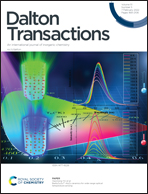An anthracene based metal–organic framework showing efficient angle-dependent polarized emission, luminescence thermometry, and photoelectronic response†
Abstract
The development of luminescent metal–organic frameworks (MOFs) has attracted extensive attention due to their applications in photoelectric devices, organic light-emitting diodes (OLEDs), anti-counterfeiting, biological imaging and so on. In this work, a novel anthracene based metal–organic framework, [Cd(DCPA)(DMF)]·(H2O) (1) (H2DCPA = 9,10-di(p-carboxyphenyl)anthracene), has been successfully synthesized under solvothermal conditions. The highly ordered arrangement and special spatial conformation of the anthracene chromophore play a significant role in the photophysical properties of 1. The combination of theoretical calculations and experiments shows that the molecular orbitals have good separation for inhibiting the recombination of electrons and holes. Furthermore, the fluorescence emission of 1 can be instantaneously and reversibly tuned between blue and green at different polarizing angles. Temperature-dependent fluorescence measurements indicate a good linear relationship between the maximum emission intensity/wavelength and the temperature for efficient thermochromism and luminescence thermometry. Photoelectric measurements reveal that 1 shows high performance of photocurrent generation under light illumination. Therefore, our research affords a new perspective to extend the application of luminescent MOFs in the fields of polarized emission, thermometry and photoelectronic response.



 Please wait while we load your content...
Please wait while we load your content...